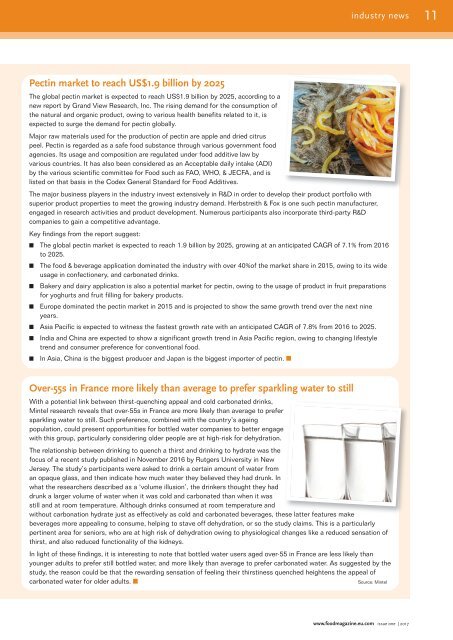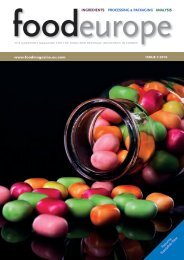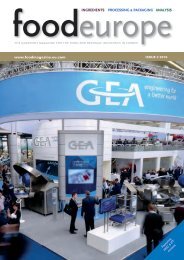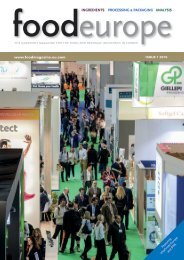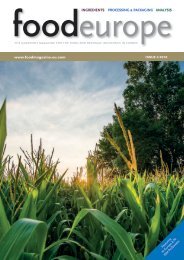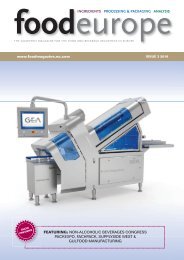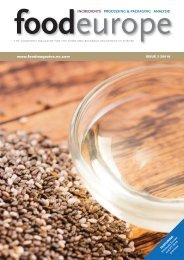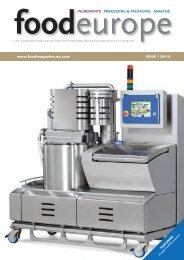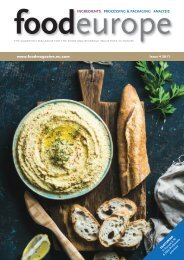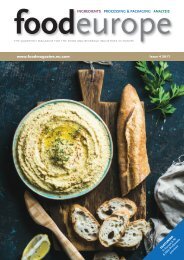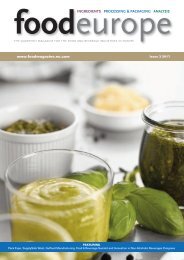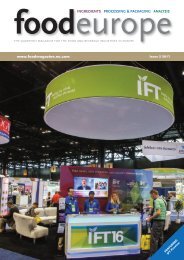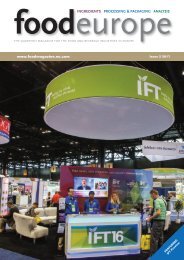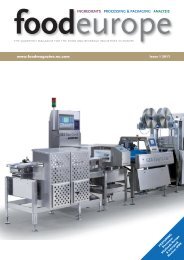issue 1 2017
Issue 1 2017 of FoodEurope Magazine
Issue 1 2017 of FoodEurope Magazine
Create successful ePaper yourself
Turn your PDF publications into a flip-book with our unique Google optimized e-Paper software.
industry news<br />
11<br />
Pectin market to reach US$1.9 billion by 2025<br />
The global pectin market is expected to reach US$1.9 billion by 2025, according to a<br />
new report by Grand View Research, Inc. The rising demand for the consumption of<br />
the natural and organic product, owing to various health benefits related to it, is<br />
expected to surge the demand for pectin globally.<br />
Major raw materials used for the production of pectin are apple and dried citrus<br />
peel. Pectin is regarded as a safe food substance through various government food<br />
agencies. Its usage and composition are regulated under food additive law by<br />
various countries. It has also been considered as an Acceptable daily intake (ADI)<br />
by the various scientific committee for Food such as FAO, WHO, & JECFA, and is<br />
listed on that basis in the Codex General Standard for Food Additives.<br />
The major business players in the industry invest extensively in R&D in order to develop their product portfolio with<br />
superior product properties to meet the growing industry demand. Herbstreith & Fox is one such pectin manufacturer,<br />
engaged in research activities and product development. Numerous participants also incorporate third-party R&D<br />
companies to gain a competitive advantage.<br />
Key findings from the report suggest:<br />
n The global pectin market is expected to reach 1.9 billion by 2025, growing at an anticipated CAGR of 7.1% from 2016<br />
to 2025.<br />
n The food & beverage application dominated the industry with over 40%of the market share in 2015, owing to its wide<br />
usage in confectionery, and carbonated drinks.<br />
n Bakery and dairy application is also a potential market for pectin, owing to the usage of product in fruit preparations<br />
for yoghurts and fruit filling for bakery products.<br />
n Europe dominated the pectin market in 2015 and is projected to show the same growth trend over the next nine<br />
years.<br />
n Asia Pacific is expected to witness the fastest growth rate with an anticipated CAGR of 7.8% from 2016 to 2025.<br />
n India and China are expected to show a significant growth trend in Asia Pacific region, owing to changing lifestyle<br />
trend and consumer preference for conventional food.<br />
n In Asia, China is the biggest producer and Japan is the biggest importer of pectin. n<br />
Over-55s in France more likely than average to prefer sparkling water to still<br />
With a potential link between thirst-quenching appeal and cold carbonated drinks,<br />
Mintel research reveals that over-55s in France are more likely than average to prefer<br />
sparkling water to still. Such preference, combined with the country’s ageing<br />
population, could present opportunities for bottled water companies to better engage<br />
with this group, particularly considering older people are at high-risk for dehydration.<br />
The relationship between drinking to quench a thirst and drinking to hydrate was the<br />
focus of a recent study published in November 2016 by Rutgers University in New<br />
Jersey. The study’s participants were asked to drink a certain amount of water from<br />
an opaque glass, and then indicate how much water they believed they had drunk. In<br />
what the researchers described as a ‘volume illusion’, the drinkers thought they had<br />
drunk a larger volume of water when it was cold and carbonated than when it was<br />
still and at room temperature. Although drinks consumed at room temperature and<br />
without carbonation hydrate just as effectively as cold and carbonated beverages, these latter features make<br />
beverages more appealing to consume, helping to stave off dehydration, or so the study claims. This is a particularly<br />
pertinent area for seniors, who are at high risk of dehydration owing to physiological changes like a reduced sensation of<br />
thirst, and also reduced functionality of the kidneys.<br />
In light of these findings, it is interesting to note that bottled water users aged over-55 in France are less likely than<br />
younger adults to prefer still bottled water, and more likely than average to prefer carbonated water. As suggested by the<br />
study, the reason could be that the rewarding sensation of feeling their thirstiness quenched heightens the appeal of<br />
carbonated water for older adults. n<br />
Source: Mintel<br />
www.foodmagazine.eu.com <strong>issue</strong> one | <strong>2017</strong>


